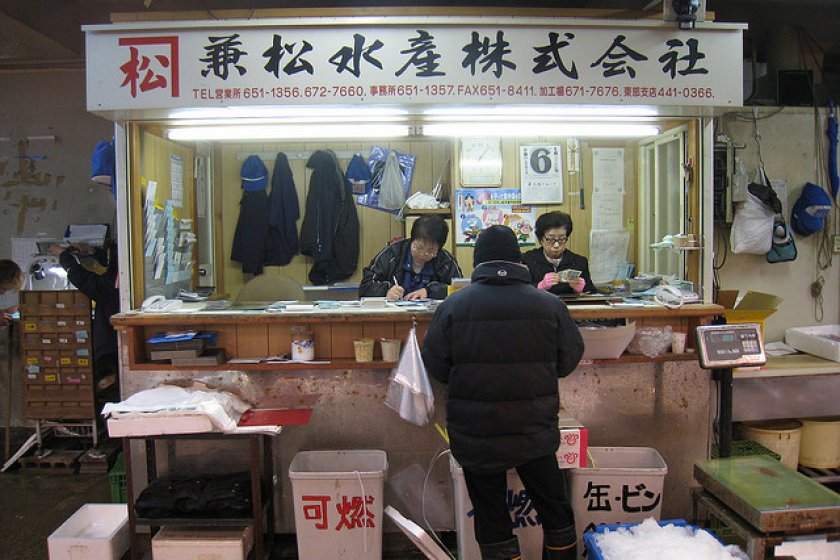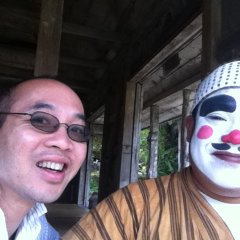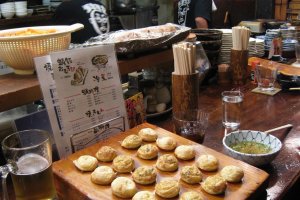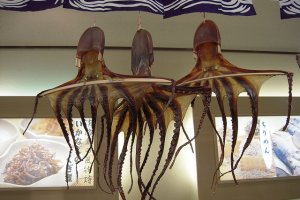Roll up! Roll up! Come here folks and catch all the action at the Kobe Uonotana Fish Markets. It is five in the morning, and while the rest of Kobe is either fast asleep or mama san is getting miso soup and breakfast ready for the family, the markets come alive with the biggest commercial fish auctions this side of Tsukiji. In fact many of the famous ryokans and eateries from Kobe to Kyoto get their fresh fish here at the Kobe Fish Markets.
From three thirty in the morning the wild commercial fish auction takes place, just seven kilometres west of Kobe by the Inland Sea. It is amazing where all this fish comes from. Crab from Hokkaido and Russia, Abalone from Mie near Nagoya, Octopus from Africa, Tuna from the Americas and Australia. Or you can even come here at eleven thirty or in the afternoon to see the daytime catch.
What I didn’t realise is that the fish you should eat in spring should be different to that in summer. The local sashimi eateries (and there are many of them) only showcase the freshest fish each season, so if you are here in Spring, try White Meat Fish like Snapper, Sea Bream or Flounder. In summer, try Sea Urchin, Eel (now I know another reason why Japanese people love eel in summer) and Abalone. In fall, Pacific Saury and Salmon is fantastic, while in winter, Yellowtail and Octopus.
Speaking of Octopus, Akashi even has its own answer to Osaka’s Takoyaki octopus meat balls. Called akashiyaki, it is also small, round and soft on the inside, with a batter filled with octopus, dashi (fish broth) and eggs. It is a fantastic snack food and the broth flavoring lifts the taste of the octopus and egg.
There must be close to a hundred shops selling seafood, kitchenware, tea and local specialities here in the markets, so it is a real gourmets’ delight, whether you are looking for your favourite sauce or going on your tenth food safari. These markets bring out the inner chef in you, but if you don’t want to cook, try the many eateries strategically dotted next to the fresh food markets. You can’t get much fresher than swimming fish.
I know there are two kinds of gourmets. One who likes to follow the best brands, and where the atmosphere and décor is an important part of the experience. The other kind just goes for the food, no matter what the décor looks like. If you think like the latter, you can’t beat the markets here. What it lacks in fancy décor, it more than makes up in taste, as you can taste some of the regional fish not available elsewhere served as sushi. There are very few tourists here, no bland globalized menus, and even Japanese from other prefectures will find this place exotic sampling the unique regional cuisine. If you can speak a little Japanese, ask their specialities and seasonal produce.
One of the local specialities is Ikanago no Kugini, which is sand eel cooked in sweet soy sauce and is a perfect accompaniment to the finest Koshihikari rice. The connection between rice and fish goes deeper than palette, they are both are sustained by water, and each meal should be a celebration of nature’s providence. The folk who are born and bred in the area have their own recipes for making Ikanago no Kugini which are passed from generation to generation, and if you don’t have a chance to try this during a homestay, you can buy it at the markets and take it home to share it with your friends. The harvest season for sand eels is early spring. After that, they return to the depths of the ocean, to escape the summer heat.
Ikanago no Kugini is also a great example of tuskundani cooking (food cooked in soy sauce). Other specialities that go well with soy sauce include roasted or grilled eel.
The food markets are open from eight to six daily except Thursday. It is a five minute walk south of JR Akashi station or Sanyo Akashi Station, and is a great place for a day trip or a stopover on the way to Himeji or points further west. JR Kansai pass holders can travel here for free, with daily unlimited ride passes from ¥2,000 taking you anywhere between Kansai Airport, Kyoto, Nara and Himeji.






























